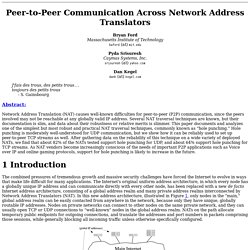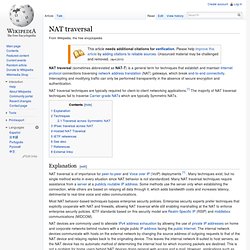

RFC 5207 - NAT and Firewall Traversal Issues of Host Identity Protocol (HIP) Communication. [Docs] [txt|pdf] [draft-irtf-hiprg-nat] [Diff1] [Diff2] INFORMATIONAL Network Working Group M.

Stiemerling Request for Comments: 5207 J. Quittek Category: Informational NEC L. Eggert Nokia April 2008 Status of This Memo This memo provides information for the Internet community. It does not specify an Internet standard of any kind. RFC 5207 HIP NAT/Firewall Traversal Issues April 2008 Table of Contents 1. RFC 5207 HIP NAT/Firewall Traversal Issues April 2008 1.
The current specification of the Host Identity Protocol (HIP) [RFC4423] assumes simple Internet paths, where routers forward globally routable IP packets based on their destination address alone. RFC 5207 HIP NAT/Firewall Traversal Issues April 2008 This document serves mainly as a problem description that solution proposals can reference. 2. This section focuses on the traversal of HIP across network address translator (NAT) middleboxes. 2.1. The HIP base exchange uses different transport mechanisms for IPv6 and IPv4. SIP with NAT or Firewalls. 1.2.1.: sip.conf port= -> The port used by asterisk for the signaling (default=5060) Bindaddr= -> The ip address on the machine asterisk has to bind to, put 0.0.0.0 to bind to all ports.

Externip= -> This is an option that has to be set in the [general] context at sip.conf and has to be set to either an ip or a hostname (pointing to the external ip on your NAT device). E.g: externip=123.123.123.123 It will set the IP address in the sip address to the external ip instead of the internal IP. Localnet= -> This is an option has to be set in the [general] context at sip.conf and has to be set to the netmask for the private network asterisk is in, this is only needed when asterisk is behind a NAT and trying to communicate with devices outside of the NAT. Peer-to-Peer Communication Across Network Address Translators. Bryan FordMassachusetts Institute of Technologybaford (at) mit.edu Pyda SrisureshCaymas Systems, Inc.srisuresh (at) yahoo.com Dan Kegeldank (at) kegel.com J'fais des trous, des petits trous toujours des petits trous - S.

Gainsbourg Abstract: Network Address Translation (NAT) causes well-known difficulties for peer-to-peer (P2P) communication, since the peers involved may not be reachable at any globally valid IP address. The combined pressures of tremendous growth and massive security challenges have forced the Internet to evolve in ways that make life difficult for many applications. The Internet's new de facto address architecture is suitable for client/server communication in the typical case when the client is on a private network and the server is in the global address realm. One of the most effective methods of establishing peer-to-peer communication between hosts on different private networks is known as “hole punching.” The rest of this paper is organized as follows.
Www.ingate.com/files/Solving_Firewall-NAT_Traversal.pdf. Nutss.gforge.cis.cornell.edu//pub/imc05-tcpnat.pdf. MediaProxy - Fast and scalable RTP relay for OpenSIPS – Trac. Sdstrowes.co.uk/talks/20081119-ice-turn-stun.pdf. Www.sysmaster.com/brochures/nat_traversal.pdf. Upnp. How Skype & Co. get round firewalls. NAT traversal. NAT traversal (sometimes abbreviated as NAT-T) is a general term for techniques that establish and maintain Internet protocol connections traversing network address translation (NAT) gateways, which break end-to-end connectivity.

Intercepting and modifying traffic can only be performed transparently in the absence of secure encryption and authentication. NAT traversal techniques are typically required for client-to-client networking applications.[1] The majority of NAT traversal techniques fail to traverse Carrier-grade NATs which are typically Symmetric NATs. Explanation[edit] Most NAT behavior-based techniques bypass enterprise security policies. Enterprise security experts prefer techniques that explicitly cooperate with NAT and firewalls, allowing NAT traversal while still enabling marshalling at the NAT to enforce enterprise security policies. Techniques[edit] The following NAT traversal techniques are available: